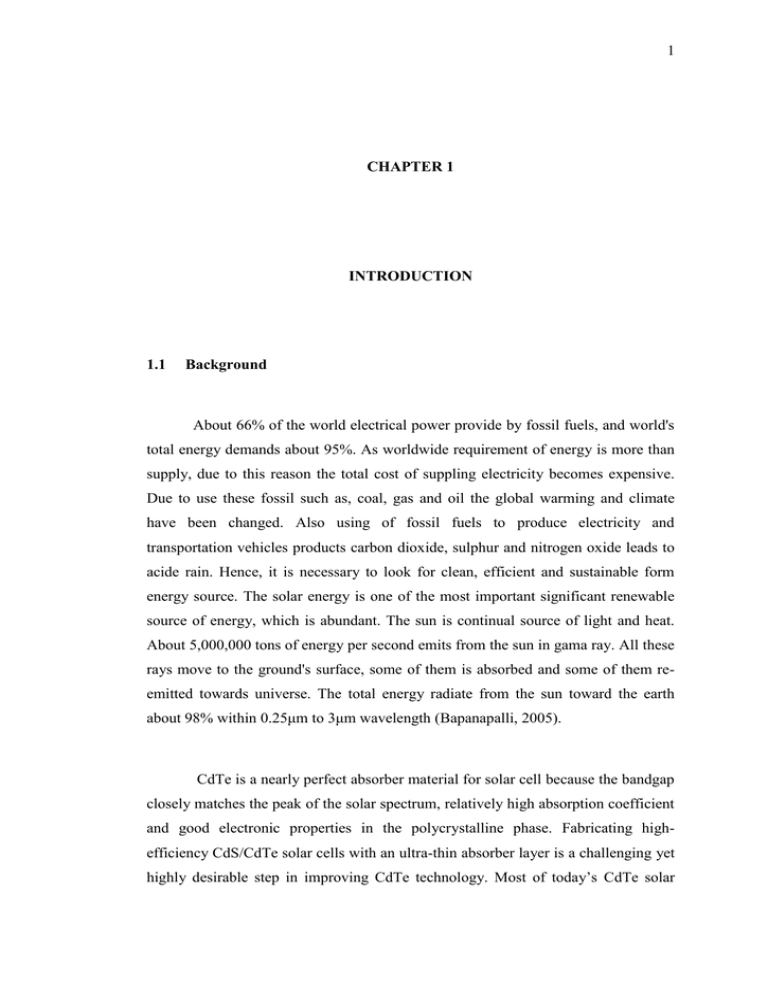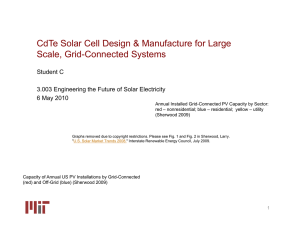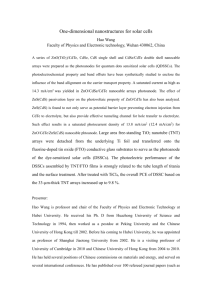1 About 66% of the world electrical power provide by fossil... total energy demands about 95%. As worldwide requirement of energy...
advertisement

1 CHAPTER 1 INTRODUCTION 1.1 Background About 66% of the world electrical power provide by fossil fuels, and world's total energy demands about 95%. As worldwide requirement of energy is more than supply, due to this reason the total cost of suppling electricity becomes expensive. Due to use these fossil such as, coal, gas and oil the global warming and climate have been changed. Also using of fossil fuels to produce electricity and transportation vehicles products carbon dioxide, sulphur and nitrogen oxide leads to acide rain. Hence, it is necessary to look for clean, efficient and sustainable form energy source. The solar energy is one of the most important significant renewable source of energy, which is abundant. The sun is continual source of light and heat. About 5,000,000 tons of energy per second emits from the sun in gama ray. All these rays move to the ground's surface, some of them is absorbed and some of them reemitted towards universe. The total energy radiate from the sun toward the earth about 98% within 0.25μm to 3μm wavelength (Bapanapalli, 2005). CdTe is a nearly perfect absorber material for solar cell because the bandgap closely matches the peak of the solar spectrum, relatively high absorption coefficient and good electronic properties in the polycrystalline phase. Fabricating highefficiency CdS/CdTe solar cells with an ultra-thin absorber layer is a challenging yet highly desirable step in improving CdTe technology. Most of today‟s CdTe solar 2 cells utilize an absorber layer which is about 2.5 μm to 8 μm thick. Thinning this layer down typically results in poorer cell performance due to shunting, incomplete photon absorption, fully depleted CdTe layer or interference between the main and the back contact junction when the CdTe layer thickness approaches a certain limit. While some of these losses are fundamental, others can be minimized by careful optimization of the fabrication steps (Rogach, 2000). Figure 1.1 shows the global market share of the different PV technologies for the years 2008 and 2009.The crystalline silicon accounts for 85% of the PV market. The biggest change this past decade has been the emergence of CdTe thin-film technology from 8% in 2008 to 13% in 2009. First Solar has brought CdTe to mass production and in 2009 it became the world‟s first PV manufacturer to exceed 1 GW/year production rate capturing 13% of the global market (Palekis, 2011). Figure 1.1: Market share for PV technologies (Palekis, 2011) 3 1.2 Problem Statement Cadmium telluride (CdTe) has been recognized as a very promising material for thin-film solar cells. Furthermore, it is a II–VI compound semiconductor with a direct optical bandgap 1.5 eV that is nearly optimally matched to the solar spectrum for photovoltaic (PV) energy conversion. It has a high absorption coefficient, which means that 99% of photons with energy greater than the bandgap (Eg) that can be absorbed within 2 cm2 of CdTe film. In contrast, cadmium sulfide (CdS) with its large bandgap and chemical stability, is an N-type semiconductor used as a window layer in many types of solar cells in conjunction with absorbers CdTe. The best cell efficiencies attained so far are 16.5% for CdTe and CdS. Thin films of CdS have been studied extensively over the past three decades (Wu et al., 2004). Based on the fact that CdS has been the most widely used and most successful N-type window layer, thin film solar cells of CdS with CdTe has proposed as a new solar cell. Various techniques such as chemical vapor deposition, magnetron sputtering, and chemical bath deposition have been used to make uniform and transparent CdS films to produce high efficiency solar cells (Kumazawa et al., 1997; Moutinho et al., 2003; Aksu et al., 2011; Bhandari et al., 2013). In the present study, different materials have been proposed to produce a high efficiency thin film solar cell layer by layer based on CdTe and CdS heterojunction by using high vacuum thermal evaporation. The gold (Au) will be used as a back contact due to its work function greater than P-type CdTe. Inaddition, silver (Ag) will be used as electrode to measure the current and voltage that created by the solar cell. 4 Solar Cells The cell Heterojunction efficiencies attained between N-type so far are 16.5% and P-type Solar Cells Thin Film Fabrication High Vacuum Evaporation Transparent Conducting Film (FTO) Cadmium Sulfide (CdS) Cadmium Telluride (CdTe) Back Contact Gold and Silver Figure1.2: Flowchart of the research work 5 1.3 Research Objectives This study embarks on the following goals: i) To fabricate CdS/CdTe solar cells using high vacuum evaporation . ii) To characterise the structure of CdS/CdTe solar cells. iii) To determine the performance of electrical characteristics based on current – voltage measurement. 1.4 Scope of the research The current study was splited into three main scopes to achieve the stated objectives. First, the proposed solar cell samples will prepared by using the basic of N-type and P-type (CdS/CdTe). As a supplementary step, gold and silver will perform as contact back materials by using high vacuum evaporation. Second, X-ray diffraction (XRD) and Field Emission Scanning Electron Microscopy (FESEM) will use to identify the structure and amorphouse phase of the prepared solar cell. Finally, a significant measurement for the current and voltage (IV) will calculate taking the consideration of dark and light effect. 6 1.5 Significant of the study The current study will be done to clarification of making CdS/CdTe solar cells by using high vacuum evaporation and using gold (Au) as contact layer with silver (Ag) for electrode. Furthermore, understanding solar cell working based in PN junction and determines electrical properties of solar cells based on current and voltage measurement in light and dark condition.

